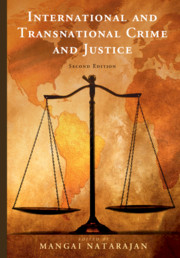Book contents
- International and Transnational Crime and Justice
- International and Transnational Crime and Justice
- Copyright page
- Contents
- Figures and Tables
- Preface
- About the Editor
- Notes on Contributors
- Introduction
- PART I OVERVIEW: TRANSNATIONAL CRIME
- PART II OVERVIEW: INTERNATIONAL CRIME
- PART IIA Core International Crimes (As Defined by the Rome Statute, 1998)
- PART IIB International Crime and Justice for Women and Children
- PART IIC International Justice
- PART III OVERVIEW: INTERNATIONAL AND TRANSNATIONAL CRIME RESEARCH
- World Map
- Index
- References
PART IIC - International Justice
from PART II - OVERVIEW: INTERNATIONAL CRIME
Published online by Cambridge University Press: 20 June 2019
- International and Transnational Crime and Justice
- International and Transnational Crime and Justice
- Copyright page
- Contents
- Figures and Tables
- Preface
- About the Editor
- Notes on Contributors
- Introduction
- PART I OVERVIEW: TRANSNATIONAL CRIME
- PART II OVERVIEW: INTERNATIONAL CRIME
- PART IIA Core International Crimes (As Defined by the Rome Statute, 1998)
- PART IIB International Crime and Justice for Women and Children
- PART IIC International Justice
- PART III OVERVIEW: INTERNATIONAL AND TRANSNATIONAL CRIME RESEARCH
- World Map
- Index
- References
- Type
- Chapter
- Information
- International and Transnational Crime and Justice , pp. 395 - 396Publisher: Cambridge University PressPrint publication year: 2019
References
REFERENCES
WEBSITES
Crime Prevention and Criminal Justice Programme (ISPAC). ispac.cnpds.org.
International Scientific and Professional Advisory Council of the UN
Office of United Nations High Commissioner for Human Rights. www.ohchr.org.
United Nations Office on Drugs and Crime. www.unodc.org.
REFERENCES
WEBSITE
United Nations Treaty Collection. https://treaties.un.org/Pages/Home.aspx?lang=en.
REFERENCES
WEBSITES
Coalition for the ICC. www.iccnow.org.
ICC Preparatory commission work. www.un.org/law/icc/prepcomm/prepfra.htm or at www.jus.unitn.it/icct82/home.html.
International Criminal Court. www.icc-cpi.int/iccdocs/asp_docs/ASP8/OR/OR-ASP8-Vol.II-ENG-Part.A.pdf.
REFERENCES
REFERENCE
REFERENCES
WEBSITES
East Timor Hybrid Court. www.eastwestcenter.org/stored/pdfs/api061.pdf.
International Criminal Tribunal for the Former Yugoslavia. www.icty.org.
International Criminal Tribunal for Rwanda. www.ictr.org.
Special Tribunal for Lebanon. stl-tsl.org.
United Nations Treaty Collection. https://treaties.un.org/Pages/Home.aspx?lang=en.
REFERENCES
WEBSITES
African Charter on Human and Peoples’ Rights. https://au.int/en/treaties/african-charter-human-and-peoples-rights.
African Union. https://au.int/en/history/oau-and-au.
European Court of Human Rights, information documents.
www.echr.coe.int/Pages/home.aspx?p=court&c=#newComponent_1346149514608_pointer.
Organization of American States human rights webpage. www.oas.org/en/topics/human_rights.asp.
UN Human Rights Council. www.ohchr.org/EN/HRBodies/HRC/Pages/AboutCouncil.aspx.
REFERENCES
WEBSITES
Centre for the Study of Violence and Reconciliation. www.csvr.org.za.
International Centre for Transitional Justice. www.ictj.org.
International Institute for Democracy and Electoral Assistance. www.idea.int.
Program on Negotiation, Harvard Law School, and European Centre for Common Ground. www.truthcommission.org.
Truth and Reconciliation Commission. www.doj.gov.za/trc.
United States Institute of Peace. www.usip.org/library/truth.html.
REFERENCES
REFERENCES
WEBSITES
Amnesty International. www.amnesty.org.
Coalition for the International Criminal Court (CICC). www.coalitionfortheicc.org.
The Conference of NGOs in Consultative Relationship with the United Nations. www.ngocongo.org.
Criminologists without Borders. www.criminologistswithoutborders.org.
Human Rights Watch. www.hrw.org.
International Rescue Committee. www.rescue.org.
New York Alliance of NGOs on Crime Prevention and Criminal Justice. www.cpcjalliance.org.
NGO Branch, UN Department of Economic and Social Affairs. http://csonet.org/.
Penal Reform International. www.penalreform.org.
Promundo. https://promundoglobal.org.
Save the Children. www.savethechildren.net/.
Soroptimist. www.soroptimist.org/.
Transparency International. www.transparency.org/.
Women Living Under Muslim Laws. www.wluml.org.
World Society of Victimology. www.worldsocietyofvictimology.org.
REFERENCES
WEBSITES
International Centre for Transitional Justice. www.ictj.org/search-results?search=re.
John Braithwaite: War, Crime and Regulation. http://johnbraithwaite.com/?s=restorative+justice.



